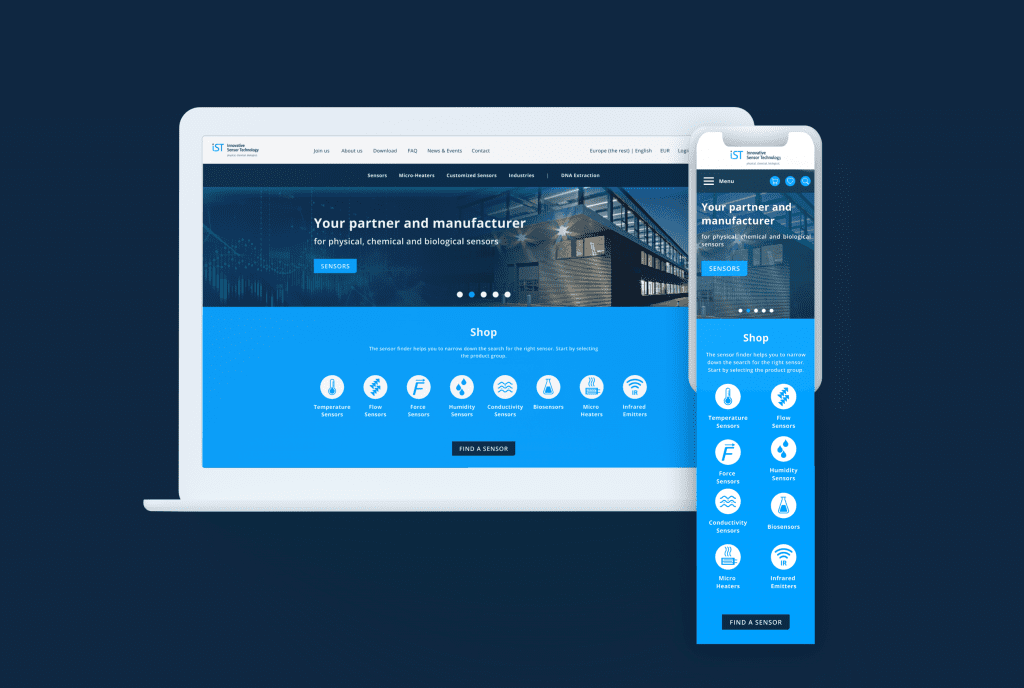Mit dem richtigen Content Management System zum perfekten Web-Auftritt
Ein professioneller Internetauftritt ist heutzutage unverzichtbar, um Kunden und Partner zu erreichen, die eigene Marke zu stärken und im Wettbewerb sichtbar zu bleiben. Dabei kommt Content Management Systeme (CMS) als technische Basis eine Schlüsselrolle zu.
Doch die Auswahl des passenden CMS kann schwierig sein. Zahlreiche Systeme buhlen mit verschiedenen Funktionen und Versprechen um die Gunst der Anwender. Welches CMS passt am besten zur eigenen Website und den konkreten Anforderungen?
In diesem Beitrag stellen wir die Vor- und Nachteile der führenden CMS-Lösungen vor. Anhand von Praxisbeispielen zeigen wir, worauf es bei der Auswahl ankommt. So lassen sich Fehlinvestitionen vermeiden und die Weichen für eine zukunftsfähige Website-Technologie stellen.
Denn das CMS bildet das Fundament für den gesamten Digitalauftritt der kommenden Jahre. Mit der richtigen Wahl spart man sich teure Migrationsprojekte und legt den Grundstein für effizientes Content Management heute und in Zukunft.
Welche Anforderungen müssen Unternehmen an ein CMS stellen?
Bei der Auswahl von Content Management Systemen sollten insbesondere folgende Anforderungen im Fokus stehen:
- Benutzerfreundlichkeit für Redakteure
- Flexibilität bei der Abbildung von Inhaltsstrukturen
- Erweiterbarkeit durch zusätzliche Plugins und Module
- Sicherheit gegen Hackerangriffe
- Leistungsfähigkeit für hohe Zugriffszahlen
- Zukunftssicherheit durch aktive Weiterentwicklung
Gerade für Unternehmenswebsites mit ambitionierten Ansprüchen an Funktionalität und Sicherheit lohnt sich der Blick über den Tellerrand der bekannten CMS-Lösungen hinaus. Im Enterprise-Bereich punkten weniger bekannte Alternativen mit überlegenen Eigenschaften.
In unserem Vergleich stellen wir insgesamt 5 Open Source CMS-Systeme vor, die sich als Fundament für professionelle Websites eignen. Dabei zeigt sich, dass die beliebteste Lösung nicht immer die beste ist. Oft lohnt es sich, tiefer in die Materie einzusteigen.
Übersicht
Was ist ein Content Management System oder CMS?
CMS steht für Content Management System. Es bildet das technische Fundament einer Website und ist eine umfassende Suite von Content-Management-Tools zur Verwaltung und Erstellung digitaler Inhalte
Im Gegensatz zu einer statischen Website werden bei einem CMS die Inhalte nicht einzeln im Quellcode hinterlegt. Stattdessen werden sie in einer Datenbank gespeichert und über eine Administrationsschnittstelle gepflegt.
Die Funktionen von Content-Management-Systemen können stark variieren. Aber fast alle bieten Kernfunktionen, wie z. B. Veröffentlichung, Revisionskontrolle, Formatverwaltung, Suchen und Abrufen sowie Indizierung
Die Vorteile eines CMS:
- Einfache Pflege der Inhalte ohne Programmierkenntnisse
- Trennung von Inhalt und Design
- Wiederverwendung von Inhalten
- Strukturierte Ablage in Kategorien, Tags etc.
- Rechtekonzepte und Workflows
- Versionsverwaltung und Änderungshistorie
Ein CMS besteht im Wesentlichen aus 3 Komponenten:
- Datenhaltung: Hier liegen die Inhalte strukturiert in einer Datenbank ab.
- Inhaltsverwaltung: Über ein Dashboard können User die Inhalte pflegen.
- Frontend: Hier werden die Inhalte dynamisch in ein Design eingebunden und als Website dargestellt.
So ermöglicht ein CMS auch fachlichen Redakteuren ohne Technik-Kenntnisse, Inhalte einfach und strukturiert zu pflegen. Es ist die Grundlage für effizientes Content Management.
Open Source CMS vs. proprietäre CMS
Bei der Auswahl eines CMS stellt sich oft die Frage: Soll man ein Open Source System oder ein proprietäres, kommerzielles System wählen? Hier die wichtigsten Unterschiede:
Was ist Open Source?
Open Source CMS haben einen öffentlich einsehbaren Quellcode, der unter einer Open-Source-Lizenz steht. Jeder kann den Code einsehen, verwenden und verbessern. Die Community trägt zur stetigen Weiterentwicklung bei.
Vorteile von Open Source CMS:
- Keine Lizenzkosten für die Software
- Unabhängigkeit von einem Anbieter
- Flexibilität durch Anpassung des Quellcodes
- Aktive Community sorgt für Innovationen
Beispiele für Open Source CMS sind WordPress, Joomla und Drupal.
Proprietäre CMS:
Proprietäre Systeme haben einen geschlossenen Quellcode, der geheim gehalten wird. Sie werden von einem Hersteller entwickelt und vertrieben.
Vorteile proprietärer CMS:
- Professioneller Support durch den Anbieter
- Geeignet wenn Anpassungen nicht nötig sind
- Eventuell einfachere Bedienung
Beispiele für proprietäre CMS sind Contao, Typo3 oder Magnolia.
Fazit:
Open Source CMS punkten durch Flexibilität, Transparenz und Unabhängigkeit von einem Hersteller. Proprietäre Systeme bieten dafür meist professionellen Support und einfache Bedienung.
Bei hohen Ansprüchen an Anpassbarkeit und Zukunftssicherheit sind Open Source CMS klar im Vorteil. Für kleinere Websites können aber auch proprietäre Systeme sinnvoll sein.
Übersicht der 5 CMS Systeme
Nachfolgend stellen wir die besten 5 CMS vor:
5. Typo3

Typo3 hat sich im Laufe der Jahre zu einem leistungsfähigen Open-Source CMS für Enterprise-Websites entwickelt. Die Software ermöglicht es, alle Arten digitaler Inhalte zentral zu verwalten.
Durch die umfangreichen Funktionen für Workflow-Management, Versionierung und Rechtevergabe lässt sich die Zusammenarbeit in grossen Teams effizient organisieren. SEO-Features, ein leistungsstarkes Frontend und die Anbindung moderner Headless-CMS-Architekturen sind weitere Pluspunkte.
In der neuesten Version wurde die Benutzeroberfläche deutlich vereinfacht. Trotz der umfangreichen Funktionalitäten ist Typo3 damit auch für weniger technik-affine Redakteure geeignet.
Vorteile von Typo3:
- Umfangreiche Funktionen für Enterprise-Anforderungen
- Hohe Flexibilität und Anpassbarkeit
- SEO-Optimierung und moderne Architektur
- Einfachere Bedienung durch Interface-Überarbeitung
Nachteile:
- Hoher Funktionsumfang kann Komplexität bedeuten
- Vergleichsweise steile Lernkurve
- kleinere Community als bei anderen Open Source CMS
Für Unternehmen, die eine flexible und leistungsfähige Open Source Lösung für ihr digitales Content Management suchen, ist Typo3 eine interessante Enterprise-Option.
Unsere Bewertung:
- Insgesamt: 3.5/5
- Benutzerfreundlichkeit: 2.8/5
- Kundenservice/ Community-Support: 2.7/5
4. Magento

Magento ist ein beliebtes Open Source CMS speziell für E-Commerce Projekte. Mit umfangreichen Funktionen für Online-Shops, Performance Optimization und flexible Preisgestaltung ist Magento eine beliebte Wahl für anspruchsvolle E-Commerce-Websites.
Die neueste Version bietet insbesondere eine stark verbesserte Page Builder Funktionalität. Über intuitive Drag & Drop Editoren lässt sich das Shop-Frontend nun auch für technische Laien einfacher anpassen.
Zudem wurde das Magento Admin Backend übersichtlicher gestaltet. Für Entwickler stehen umfangreiche APIs und Integrationsmöglichkeiten bereit.
Vorteile von Magento:
- Umfangreiche E-Commerce-Funktionen
- Hohe Performance auch bei grossem Traffic
- Flexible Preis- und Produktgestaltung
- Moderne Page Builder für einfache Frontend-Bearbeitung
Nachteile:
- Hohe Komplexität, steile Lernkurve
- Hosting und Development tendenziell teurer
- Release-Zyklen teilweise langsam
Für ambitionierte E-Commerce-Projekte ist Magento dank der umfassenden Features und aktuellen Verbesserungen eine gute Wahl. Allerdings sind die höheren Kosten zu berücksichtigen.
Unsere Bewertung:
- Insgesamt: 3.6/5
- Benutzerfreundlichkeit: 3.0/5
- Kundenservice/ Community-Support: 3.2/5
3. Joomla

Joomla hat sich im Laufe der Jahre zu einer beliebten Open Source Lösung für mittelgrosse Websites entwickelt. Das CMS punktet mit Flexibilität in der Gestaltung und umfangreichen Erweiterungsmöglichkeiten.
Die neueste Version bringt vor allem Verbesserungen in den Bereichen Usability und Geschwindigkeit. Die Oberfläche wurde modernisiert und die Performance optimiert.
Joomla eignet sich ideal für Community-Websites, Blogs, Online-Magazine und Webauftritte mit vielfältigen Inhalten. Durch die umfangreichen User-Management-Features lassen sich auch komplexe Mitgliederbereiche abbilden.
Vorteile von Joomla:
- Hohe Anpassbarkeit durch Templates und Erweiterungen
- Umfangreiche Benutzer- und Berechtigungsverwaltung
- Gute SEO-Funktionen
- Modernisierte Oberfläche und verbesserte Performance
Nachteile:
- Hoher Funktionsumfang kann Komplexität bedeuten
- Vergleichsweise kleine Entwickler-Community
- Weniger Template-Auswahl als beispielsweise bei WordPress
Joomla lohnt sich für mittelgrosse Websites, die hohen Gestaltungsspielraum und umfangreiche Nutzerverwaltung erfordern. Durch die aktuellen Verbesserungen ist es eine valide Open Source Lösung.
Unsere Bewertung:
- Insgesamt: 3.9/5
- Benutzerfreundlichkeit: 3.6/5
- Kundenservice/ Community-Support: 3.8/5
2. WordPress

WordPress hat den grössten Marktanteil unter den Content-Management-Systemen. Obwohl es ursprünglich als Blogging-Plattform konzipiert wurde, hat es sich seither erheblich weiterentwickelt.
Die intuitive Oberfläche von WordPress macht die Plattform einfach zu bedienen. Benutzer können aus Tausenden von verfügbaren Themes und Plugins wählen, um den Inhalt anzupassen.
WordPress bietet umfangreiche Werkzeuge zur Verwaltung von Inhalten. Der vielseitige Editor ermöglicht es, Inhalte einfach zu formatieren. Auch das Veröffentlichen neuer Seiten und Beiträge ist einfach und bequem.
Der Hauptvorteil von WordPress ist die Einfachheit, mit der Benutzer Inhalte aktualisieren können. Die Plattform verwendet den Template-Ansatz, um das Design der Website zu ändern. Dieser benutzerfreundliche Ansatz ermöglicht es, Inhalte, Bilder und Logos hinzuzufügen und das Layout bequem zu ändern.
Die freundliche und aktive Entwicklergemeinschaft von WordPress stellt regelmässig Sicherheitsupdates und neue Funktionen zur Verbesserung der Plattform bereit.
Die Funktionalität von WordPress kann durch Plugins von Drittanbietern wie Yoast SEO und Woo commerce erweitert werden. Mit dem Yoast SEO-Plugin kann man Keywords optimieren, Inhalte aktualisieren, Lesbarkeitsprüfungen durchführen und vieles mehr. Dieses Plugin erweitert die grundlegenden On-Page-SEO-Funktionen dieses CMS erheblich.
WordPress wird von etwa 34% des Webs verwendet, darunter Top-Websites mit Millionen von Besuchern. Dies beweist die Skalierbarkeit der Plattform. Die Entwicklergemeinschaft hat robuste Sicherheitskomponenten in die Software integriert, um allen Arten von Sicherheitsbedrohungen entgegenzutreten.
Vorteile:
- Kostenlos und Open Source (einige kostenpflichtige Premium-Plugins)
- Sehr gut geeignet für leichte Websites, d.h. Blogs und Inhaltsseiten
- Kann sehr benutzerfreundlich mit einem leistungsstarken Front-End Drag and Drop Editor konfiguriert werden, um neue Seiten mit angepassten Layouts zu erstellen
- Grosse Auswahl an kostenlosen und kostenpflichtigen Plugins, um eine Vielzahl von Funktionen abzudecken
Nachteile:
- Aufgrund der grossen Gemeinschaft von Mitwirkenden gibt es in einigen Plugins schlechten Code mit unterdurchschnittlichen Sicherheitsstandards
- Aufgrund der obigen Ausführungen kann es zu Konflikten zwischen Plugins sowie zu potenziellen Sicherheitsbedrohungen kommen, die von erfahrenen WordPress-Entwicklern behoben werden müssen, die über solide Erfahrungen mit WordPress-Sicherheit verfügen
- Wartung, Sicherheit und Updates müssen von WordPress-Experten durchgeführt werden, damit die Plattform sicher und betriebsbereit bleibt
Unsere Bewertung:
- Insgesamt: 4.4/5
- Benutzerfreundlichkeit: 4.5/5
- Kundenservice/ Community-Support: 4.5/5
1. Drupal 10

Drupal ist eines der bekanntesten Content-Management-Systeme. Obwohl Drupal einen kleineren Marktanteil als WordPress und Joomla hat, ist es ein funktionsreiches und vielseitiges Werkzeug. Ausserdem ist es komplett kostenlos und Open Source.
Drupal ermöglicht es, benutzerdefinierte Beiträge über ein flexibles System zu verwalten. Es bietet ein hohes Mass an Kontrolle über Berechtigungen für autorisierte Benutzer. Es hat auch die Fähigkeit, mehrsprachige Sites zu verwalten.
Mit Drupal können Benutzer alle Arten von Inhalten in ihre Website integrieren: Blogbeiträge, Umfragen, Nachrichten, Foren, Informationsseiten, Powerblogs und mehr. Drupal gilt als sicherer als seine beiden Hauptkonkurrenten, Joomla und WordPress.
Basierend auf dem vierteljährlichen Bericht über gehackte Websites sind Drupal-Websites weniger anfällig für Hackerangriffe und Sicherheitsbedrohungen, weshalb es die bevorzugte Wahl für Regierungsbehörden und grosse Organisationen ist. Beispiele für mit Drupal betriebene Websites sind die australische Regierung, Pinterest, Twitter, eBay, die Harvard University, Nokia und die NASA.
Auf der offiziellen Drupal-Website werden regelmässig Sicherheitsberichte veröffentlicht. Das Security Advisory Team von Drupal befasst sich mit den neuesten Sicherheitslücken und entwickelt schnell Sicherheitspatches.
Benutzer können die Sicherheitsparameter mühelos über das Admin-Panel verwalten. Durch die Installation wichtiger Drupal-Sicherheitsmodule und neuer Sicherheitspatches können Sie Ihre Website gegen die neuesten Bedrohungen schützen. Darüber hinaus ermöglichen die Skalierbarkeitsfunktionen Inhaltsentwicklern, ihre Websites nahtlos zu erweitern. Somit ist Drupal 10 eine robuste Lösung für schnell wachsende Unternehmen und Betriebe.
Führende Websites migrieren zu Drupal 10 wegen seiner Skalierbarkeitsfunktionen. Es wird aufgrund seiner Fähigkeit, schwankenden Traffic effizient zu verwalten, schnell angenommen. Dieses Framework hat sich zur führenden Wahl für grosse Unternehmen und die Webziele mit dem grössten Nutzer-Traffic entwickelt.
Ein gewisses Mass an Fachwissen ist erforderlich, um diese Plattform effektiv zu bedienen. Benutzer mit Erfahrung in der Webentwicklung werden mit Drupal 10 besser zurechtkommen.
Allerdings erhält man kostenlose Hilfe von der kooperativen Community. Es gibt Chatrooms, Benutzergruppen und Supportforen die aktiv weiterhelfen. Benutzer können auch auf die Support-Dokumentation zurückgreifen.
Drupal 10 bietet gut integrierte SEO-Module für Suchmaschinenoptimierung, Analyse und Reporting. Das intuitive und benutzerfreundliche Dashboard integriert Webmaster-Tools mit Analyseberichten. Eingebaute SEO-Tools, wie Yoast SEO, ermöglichen die Aktualisierung und Automatisierung von SEO bei enormen Mengen von Inhalten.
Das CMS hat eine breite Palette von Modulen, um alle Arten von Websites zu erstellen. Entwickler verwenden Drupal 10 daher für hochfrequentierte E-Commerce-Seiten, Social Communities, Informationsseiten, Blogs, katalogartige Seiten und mehr.
Drupal 10 verwaltet effizient alle Bedürfnisse einer Website durch tausende von Modulen. Diese Module bieten Lösungen für SEO, Social Media, Performance, Backup, Login, Umfragen, Sicherheit und CRM. Daher kann die Entwicklungszeit mit diesen agilen Modulen erheblich reduziert werden.
Ein weiterer Vorteil von Drupal 10 ist der integrierte und aüsserst benutzerfreundliche Front-end Drag & Drop Editor «Layout Builder». Er ermöglicht direkt im Front-end Anpassungen vorzumehmen, ohne dies über das Back-end zu tun. Somit hat Drupal auch in Punkte Benutzerfreundlichkeit und Einfachheit der Bedienung den Vorsprung von WordPress in diesem Punkt aufgeholt.
Der saubere eingebaute Source Code von Drupal 10 ermöglicht es Entwicklern, die Veröffentlichung von Inhalten bequem zu verwalten. Man kann aus mehreren Integrationen und Modulen von Drittanbietern wählen, um Websites nach ihren Anforderungen zu entwickeln.
Drupal senkt die Betriebskosten komplexer Websites, indem es eine breite Palette von Entwicklungswerkzeugen für Profis bietet. Aufgrund seiner Flexibilität können Entwickler mit Drupal 10 Farben, Themes von Drittanbietern, Stock-Bilder, Schriftarten, Schemata, Foren, Umfragen, Blogs, Webseiten und vieles mehr einfach anpassen und verwalten.
Vorteile:
- Alle Module sind kostenlos und Open Source
- Sehr gut geeignet für grössere, schwerere Websites mit vielen Inhalten, Schnittstellen und hohen Sicherheitsanforderungen
- Die neue Layout-Builder-Funktion stattet Drupal mit einem Front-End-Drag-and-Drop-Builder aus, der es noch benutzerfreundlicher macht
- Hohe Sicherheitsstandards und die geringste Anzahl an Hackerangriffen unter den am häufigsten eingesetzten CMS-Systemen
- Grosse Auswahl an gewarteten, stabilen und zuverlässigen Modulen, die es erlauben, eine Vielzahl von Funktionen hinzuzufügen
- Sehr robust mit hohem Mass an Flexibilität bei der Modellierung von Daten, Inhaltstypen, Views und Taxonomien
- Langlebigkeit und Flexibilität zur Anbindung von Headless Front-Ends über APIs: Drupal ist ein CMS, das eine mehrjährige Zeitspanne hat. Wenn das Design der Website veraltet, ist es möglich, nur das Frontend zu ersetzen, während das CMS/Backend für viele Jahre bestehen bleiben kann.
Nachteile:
- Längere Lernkurve im Vergleich zu WordPress für unerfahrene CMS-Benutzer
- Die anfängliche Hosting-Einrichtung und -Architektur muss von einem Drupal-Experten eingerichtet werden und ist im Vergleich zu anderen CMS-Systemen zeitaufwändiger
Unsere Bewertung:
- Insgesamt: 4.8/5
- Benutzerfreundlichkeit: 4.6/5
- Kundenservice/ Community-Support: 4.8/5
Warum sich Drupal 10 als CMS für anspruchsvolle Websites empfiehlt
Drupal 10, die neueste Version der beliebten Open-Source-Software, wurde speziell für komplexe und enterprise-taugliche Websites entwickelt. Es zeichnet siss durch folgende Eigenschsften aus:
- Hohe Performance und Stabilität auch bei grossem Trafficaufkommen
- Umfassende Content-Management-Funktionen für vielfältige Inhalte
- Enterprise-Level-Sischerheit und Granularität bei den Zugriffsrechten
- Flexibilität und Erweiterbarkeit dank der Vielzahl verfügbarer Module
- Ansprechendes Frontend-Editing dank des neuen Layout Builders
- Headless-CMS-Funktionalität für die Anbindung moderner Frontends
- Zukunftssiser und langfristig wartenbar dank Open-Source-Modell
Drupal 10 ermöglicht es, alle Arten von Inhalten wie Blogbeiträge, Produktseiten, News, Events, Foren etc. effizient in einer Website zusammenzuführen. Dank des granularen Berechtigungssystems können beliebig differenzierte Zugriffsrechte für Redakteure vergeben werden.
Über 45’000 frei verfügbare Module erlauben es, Drupal 10 gezielt um vielfältige Funktionen von der einfachen Bildergallerie bis zum komplexen E-Commerce-Shop zu erweitern. Und der neue Layout Builder macht das Frontend-Editing von Inhalten so einfach wie noch nie.
Drupal 10 – Die optimale Wahl für anspruchsvolle Websites grosser Unternehmen
Drupal 10 hat sich bei vielen Enterprise-Websites global führender Marken bewährt, wie zum Beispiel:
- Tesla
- Johnson & Johnson
- Stanford University
- Harvard University
- University of Colorado Boulder
- Warner Music Group
- Samsung
- Verizon
- NASDAQ
- NBC Sports
Diese Unternehmen setzen für ihren Internetauftritt auf Drupal 10 als zukunftssicheres CMS, das ihre komplexen Anforderungen optimal abdeckt. Die Enterprise-Version von Drupal 10 umfasst exklusive Module für erweiterte Funktionalität.
Auch für E-Commerce-Websites mit hohen Traffic-Volumen ist Drupal dank seiner Skalierbarkeit bestens geeignet. Beispiele sind Tesla,NAMESPACE Motors oder Paul Smith. Die führenden Drupal-Agenturen bieten fertige Lösungen für Onlineshops auf Basis von Drupal Commerce an.
Eine Studie zeigt, dass über 50% der Unternehmen mit den höchsten Website-Traffic Drupal als CMS einsetzen. Drupal-Websites sind im Durchschnitt anspruchsvoller und haben mehr Traffic als jene mit WordPress oder anderen CMS.
Was sind die Optionen für eine Drupal-Migration?
Migration von Drupal 7 auf Drupal 10
Option 1: Bleiben Sie auf Drupal 7 und aktualisieren Sie gleichzeitig Ihre PHP-Version. Wenn Sie heute noch auf Drupal 7 sind, können Sie entweder einen Anbieter für einen langfristigen Supportvertrag engagieren oder auf Drupal 10 migrieren.
Option 2: Migrieren Sie zu Drupal 9, damit es einfacher ist, auf Drupal 10 zu aktualisieren.
Wie auf Drupal.org beschrieben, bedeutet ein Upgrade von Drupal 7 auf Drupal 8 bzw. 9 ein grosses Versions-Update, was fast so ist, als würde man eine neue Website von Grund auf neu starten. Sie müssen zunächst eine saubere Drupal 9 Website installieren. Dann migrieren Sie Ihre Site-Konfiguration und den Site-Inhalt auf Ihre neue Drupal 10-Seite.
Migration von Drupal 8 auf Drupal 10
Halten Sie Ihre Drupal 8 Website auf dem neuesten Stand, damit Sie für Drupal 9 bzw. ab 2023 für Drupal 10 bereit sind.
Die Migration von Drupal 8 auf Drupal 9 und 10 ist ein wesentlich einfacheres Unterfangen als die Migration von Drupal 7, solange alle Drupal 9-Updates gewissenhaft implementiert wurden.
CMS im Praxistest – wann lohnt sich welches System?
Ob ein CMS die eigenen Anforderungen optimal erfüllt, hängt stark vom konkreten Anwendungsfall ab. Anhand von praktischen Beispielen wird deutlich, wofür sich welche Lösung am meisten lohnt.
WordPress: Ideal für Blogs und einfache Websites
Für Blogs, kleine Unternehmenswebsites oder Online-Visitenkarten empfehlen wir als Webagentur in Zürich meist WordPress als die beste Wahl. Die einfache Bedienung ermöglicht es auch technischen Laien, in kurzer Zeit eine optisch ansprechende Website zu gestalten.
Plugin-Erweiterungen sorgen für zusätzliche Funktionalität, von der Bildergalerie bis zum einfachen Shop. Ein Beispiel ist die Website DAB+ das wir für Scholz & Friends und das Bundesamt für Kommunikation (BAKOM) entwickelt haben.

Joomla: Vorteil bei Community-Websites und Mitgliederbereichen
Joomla kann seine Stärken vor allem bei Community-getriebenen Websites mit Mitgliederbereich und Forum ausspielen.Ein Beispiel hierfür ist das Guggenheim Museum:

Durch die Mitgliederverwaltung und erweiterten Zugriffsrechte empfehlen wir als Digitalagentur Zürich Joomla ideal für diesen Anwendungsfall.
Drupal: Überlegen bei Enterprise-Websites und Online-Shops
Komplexe E-Commerce-Projekte, Unternehmenswebsites und Online-Plattformen mit hohen Anforderungen an Performance und Sicherheit sind die Domäne von Drupal.
Ein Beispiel ist der B2B-Online-Shop der Innovative Sensor Technologies IST AG, für den unsere Drupal Agentur Zürich Drupal gewählt hat:

Durch die Enterprise-Fähigkeiten und skalierbare Performance ist Drupal prädestiniert für diese Art komplexer Websites.
So wird klar: Es kommt immer auf den Einsatzfall an. Sind die Anforderungen überschaubar, ist WordPress meist die einfachste Wahl. Mit wachsender Komplexität punkten aber CMS wie Drupal mit ihrer Enterprise-Ausrichtung.
Für eine individuelle Empfehlung sprechen Sie uns gerne an. In einem Beratungsgespräch finden wir gemeinsam die optimale CMS Lösung für Ihr Projekt heraus.
Fazit – zukunftssicher ins Content Management starten
Bei der Auswahl des Content-Management-Systems gibt es viel zu beachten. Besonders wichtig ist es, die konkreten Anforderungen zu bedenken und nicht blind dem aktuellen Hype zu folgen.
Für viele einfache Websites ist WordPress zweifellos eine solide Wahl, gerade für Einsteiger. Möchte man aber von Anfang an die Weichen für zukünftiges Wachstum stellen, sind Enterprise-Lösungen wie Drupal oft die bessere Investition.
Wir helfen Ihnen gerne, das passende CMS für Ihre Website zu finden und einen zukunftssicheren Grundstein zu legen. Sprechen Sie uns an und vereinbaren Sie noch heute Ihr kostenloses Beratungsgespräch.
Warum wir Drupal 10 bei vielen Gelegenheiten anderen CMS vorziehen
Von allen verfügbaren CMS-Optionen ist Drupal definitiv die beste für kundenspezifische Plattformen, die in der Lage sind, eine breite Palette von Unternehmensanforderungen zu bedienen. Es ist im Vergleich zu Joomla und WordPress technisch fortschrittlicher. Aber es verbraucht trotzdem weniger Systemressourcen. Dies gewährleistet optimierte Ladegeschwindigkeiten, Performance und Responsiveness der Website. Daher ist Drupal die bevorzugte CMS-Wahl für B-works und erfahrene Entwickler weltweit, beim Erstellen von komplexen Seiten mit hohen Sicherheitsanforderungen.
Forrester erwähnt in seinem Report, dass Websites schnell in Richtung Drupal 9 bzw. per Dezember 2022 auf Drupal 10 migriert haben.
In welchen Fällen wir WordPress empfehlen
Bei einfacheren Seiten, die schnell erstellt werden müssen, bzw. weniger komplex sind und bei denen Nutzerfreundlichkeit für den Administrator wichtiger ist, verwenden wir gerne WordPress.
Der höchste Prozentsatz an Migrationen von Websites ist von WordPress zu Drupal
Drupal 10 ist die Zukunft der Website-Technologie. Es ist in hohem Masse in der Lage, Front-End- und Back-End-APIs zu unterstützen, Inhaltsmetadaten zu organisieren, dynamische Inhalte anzupassen und mehr.
Aufgrund seiner modularen Natur bietet die Adoption von Drupal 10 eine breite Palette von nachhaltigen, sicheren und von der Community unterstützten Optionen.
Dank der frei verfügbaren Module wird viel weniger Entwicklungszeit benötigt, um Websites mit personalisierten Funktionalitäten zu erstellen.
Aufgrund seiner stabilen und robusten Architektur ist Drupal 10 dafür gemacht, grosse Schwankungen im Internetverkehr zu bewältigen. Es kann effizient grosse Ströme von Inhalten für höheren Traffic bereitstellen. Daher wird Drupal 10 das CMS der Wahl für Top E-Commerce Websites und führende Unternehmen.
Über B-works – wir realisieren Ihren digitalen Markenauftritt auf Basis des idealen CMS
Wir sind ein Team aus erfahrenen Digital-Experten mit einer Mission: Unternehmen dabei zu unterstützen, sich optimal im World Wide Web zu präsentieren.
Durch unsere langjährige Erfahrung mit diversen CMS-Systemen und Technologien finden wir für jedes Projekt die optimale Lösung.
Unser Service umfasst:
- Auswahl und Implementierung des passenden CMS
- Planung und Konzeption von Websites, Online-Shops und Web-Applikationen
- Frontend- und Backend-Entwicklung
- Projektmanagement und Qualitätssicherung
- Support, Wartung und Weiterentwicklung
Profitieren Sie von unserem Know-how und unserer Leidenschaft für digitale Projekte. Wir stehen für transparente Preise, flexible Umsetzung und zuverlässige Qualität.
Gemeinsam machen wir Ihren Internetauftritt zum Erfolg.
Wir freuen uns auf Ihr Projekt.
